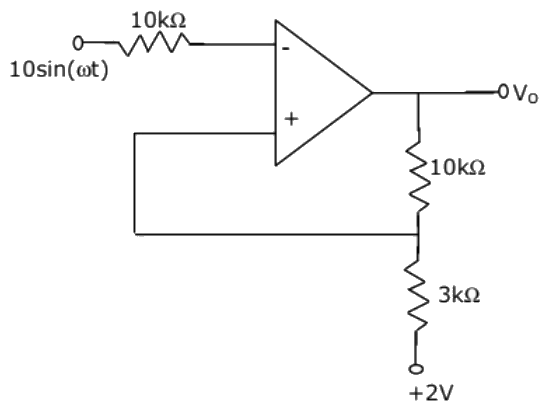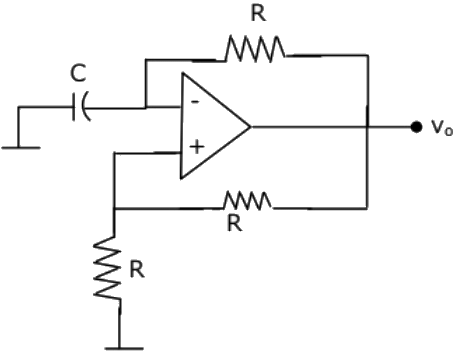Previous Year Questions- Oscillators and Feedback Amplifiers | Analog and Digital Electronics - Electrical Engineering (EE) PDF Download
Q1: A current controlled current source (CCCS) has an input impedance of 10 Ω and output impedance of 100 kΩ. When this CCCS is used in a negative feedback closedloop with a loop gain of 9, the closed loop output impedance is (2019)
(a) 10 Ω
(b) 100 Ω
(c) 100 kΩ
(d) 1000 kΩ
Ans: (d)
Sol: "CCCS" (Current controlled current source amplifier)
Given, Z0 = 100kΩ
Loop gain, Aβ = 9
Z0F = Z0[1 + Aβ] (High impedance CS)
= 100kΩ[1 + 9]
= 100kΩ × 10
= 1000kΩ
Q2: A hysteresis type TTL inverter is used to realize an oscillator in the circuit.
If the lower and upper trigger level voltages are 0.9 V and 1.7 V, the period (in ms), for which output is LOW, is _____. (SET-3(2014))
(a) 0.32
(b) 0.63
(c) 0.82
(d) 0.98
Ans: (b)
Sol: Discharging curve,
Vc(t) = 0 − (0−1.7)e−t/RC
At, t = T2
Vc(t) = 0.9V
0.9 = 1.7e−t/RC
0.63 = T2
T2 = 0.63ms
Q3: An oscillator circuit using ideal op-amp and diodes is shown in the figure. The time duration for +ve part of the cycle is Δt1 and for -ve part is Δt2. The value of
The time duration for +ve part of the cycle is Δt1 and for -ve part is Δt2. The value of  will be ______. (SET-2 (2014))
will be ______. (SET-2 (2014))
(a) 0.6
(b) 0.8
(c) 2
(d) 2.4
Ans: (b)
Sol: This circuit is a stable multivibrator (or) free running oscillator.
When V0 = +Vsat Vc = Vfinal + (Vinital − Vfinal)e−t/RC
Vc = Vfinal + (Vinital − Vfinal)e−t/RC
In time t = Δt1
Vc = VUTP; Vinitial = VLTP; Vfinal = +Vsat eΔt1/RC = 2....(i)
eΔt1/RC = 2....(i)
In time t = Δt2
Vc = VLTP; Vinitial = VUTP; Vfinal = −Vsat
 From equation (i) and (ii),
From equation (i) and (ii),

Q4: In the Wien Bridge oscillator circuit shown in figure, the bridge is balanced when (SET-1(2014)) (a)
(a) 
(b) 
(c) 
(d) 
Ans: (c)
Sol: 
 (a) The input impedance increases and output impedance decreases
(a) The input impedance increases and output impedance decreases(b) The input impedance increases and output impedance also increases
(c) The input impedance decreases and output impedance also decreases
(d) The input impedance decreases and output impedance increases
Ans: (a)
Sol: The given configuration is a voltage-series feedback configuration.
So, the input impedance increases
Rif = Ri(1 + Aok)
So, the output impedance decreases
Rof =

Q6: The typical frequency response of a two-stage direct coupled voltage amplifier is as shown in figure (2005)
(a)  (b)
(b)  (c)
(c)  (d)
(d)  Ans: (b)
Ans: (b)
Q7: The feedback used in the circuit shown in figure can be classified as (2004)
 (a) shunt-series feedback
(a) shunt-series feedback(b) shunt-shunt feedback
(c) series-shunt feedback
(d) series-series feedback
Ans: (b)
Sol: Equivalent circuit can be drawn with input voltage comparison and current feedback. It is shunt-shunt feedback.
Q8: The output voltage (V0) of the Schmitt trigger shown in figure swings between +15V and -15V. Assume that the operational amplifier is ideal. The output will change from +15V to -15V when the instantaneous value of the input sine wave is (2002)
 (a) 5 V in the positive slope only
(a) 5 V in the positive slope only(b) 5 V in the negative slope only
(c) 5 V in the positive and negative slopes
(d) 3 V in the positive and negative slopes
Ans: (a)
Q9: For the oscillator circuit shown in figure, the expression for the time period of oscillation can be given by (where τ = RC) (2001)
 (a) τ ln 3
(a) τ ln 3(b) 2τ ln 3
(c) τ ln 2
(d) 2τ ln 2
Ans: (b)
Sol: T = 2RC ln 3 = 2τ ln 3
Q10: An op-amp has an open-loop gain of 105 and an open-loop upper cutoff frequency of 10 Hz. If this op-amp is connected as an amplifier with a closed-loop gain of 100, then the new upper cutoff frequency is (2001)
(a) 10 Hz
(b) 100 Hz
(c) 10 kHz
(d) 100 kHz
Ans: (c)
Sol: AOL = 105
f = 10Hz
 f'2 = f2(1 + βAOL)
f'2 = f2(1 + βAOL)= 10 × 103Hz
= 10kHz
|
135 videos|181 docs|71 tests
|
FAQs on Previous Year Questions- Oscillators and Feedback Amplifiers - Analog and Digital Electronics - Electrical Engineering (EE)
| 1. What are the key differences between an oscillator and an amplifier in electrical engineering? |  |
| 2. How do negative feedback and positive feedback affect the stability of an oscillator? |  |
| 3. What are the common types of oscillators used in electrical engineering? |  |
| 4. How does the phase shift in a feedback amplifier influence its performance? |  |
| 5. What role do operational amplifiers (op-amps) play in feedback amplifier designs? |  |
















